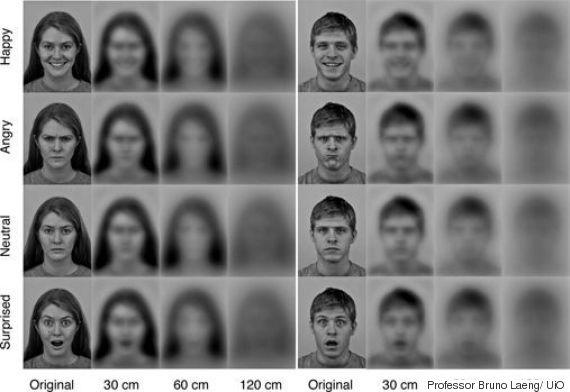
How do newborn infants see the people around them?
For the first time ever, scientists in Sweden and Norway have simulated how our emotional expressions appear to the dewy eyes of a newborn -- and their finding may lay to rest a longstanding debate.
"We have for many years known that newborn babies have poor eyesight, they do not discriminate colors and that [they] have very low visual acuity," Dr. Svein Magnussen, professor emeritus of psychology at the University of Oslo in Norway and co-author of the study, told The Huffington Post in an email. "We now know that newborn infants may be able to see and possibly react to human faces and human facial expressions. That has been a debate in development psychology."
For the study, the researchers produced moving images of adult faces expressing various emotions and filtered out the visual information that newborn infants can't perceive, The Telegraph reported. The researchers decided what to filter out based on previous studies that indicated how young infants perceive structure, contrast, spacing, and other visual cues.
(Story continues below image.)
The complete set of simulated images used in the experiment, containing the facial expressions of feeling surprised, happy, angry, and neutral.
The researchers showed the images to 48 adults to determine whether they could perceive the expressions after some of the visual data had been eliminated.
"We took those data and created dynamic images with the bad resolution and contrast of newborn infants and reasoned that if an adult human subject could make out what was presented, a newborn child could, in principle, do it too," study co-author Prof. Claes von Hofsten, a psychology professor at Uppsala University in Sweden, told The Huffington Post in an email. "However, if an adult could not make out what was shown, a newborn could not do it either."
What did the researchers find? The adults correctly identified expressions in three out of four faces when viewing them at a distance of 30 centimeters (or nearly one foot). Based on how well the adults could make out emotions in the simulations, the researchers concluded that infants as young as two days old also could see their parents' expressions at a distance of about 30 centimeters, which is about the same distance between a breastfeeding mother and her nursing baby.
But when the distance increased, the rate of identifying expressions dropped to about what the researchers would expect from random testing -- which suggests that babies' vision is too blurry to perceive expressions beyond that distance.
The researchers noted that they only examined what newborn infants can see and not whether they are able to make sense of it. Therefore, more research is needed to determine whether newborns understand -- and can imitate -- facial expressions.
"Our position is: Now a piece of the foundation is in place. If anyone else wants to follow up, that's up to them," Magnussen said in a written statement.
The study was published in the November 2014 issue of the Journal of Vision.
